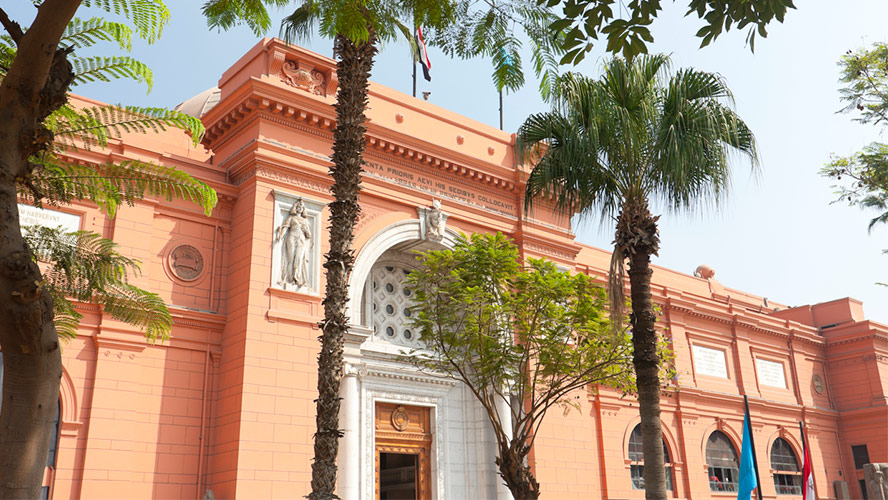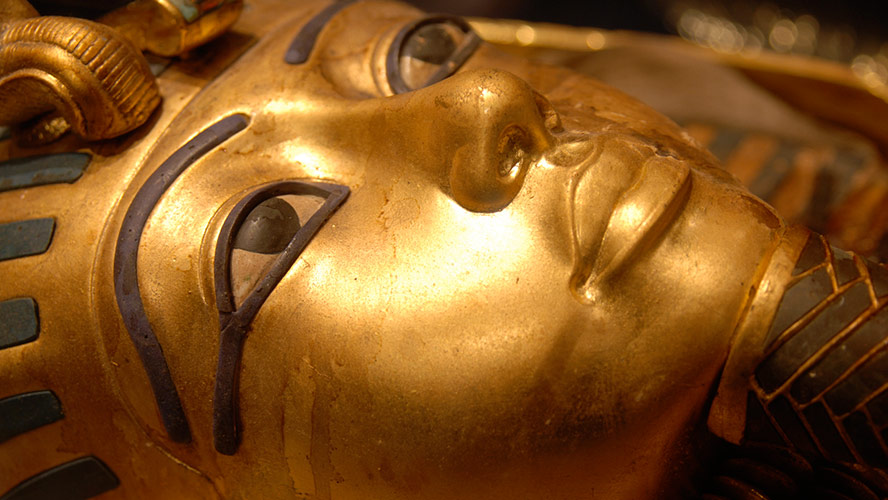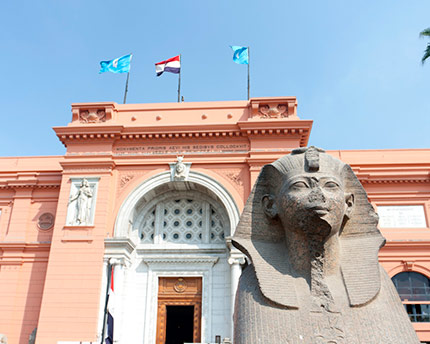The Egyptian Museum of Antiquities is located in the heart of Cairo, in Tahrir Square, in one of those buildings that speak of history, explorers, old finds and infinite collections that are spread out, as best they can, throughout the rooms. The museum has housed up to more than 100,000 items spanning the entire Pharaonic period of Egypt. The collection is so vast that some of it has been stored for centuries in cellars without ever having a chance to see the light of day in worthy display cases.
The museum, which is capable of enrapturing history and archaeology lovers, became too small a long time ago but it is only recently that the construction of two more museums began, where part of its collections can be displayed as they deserve to be. One of these museums can now be visited, i.e. the National Museum of Egyptian Civilisation. It opened partially in 2017 with a good sample of textiles, ceramics, wood and decorative objects, and fully in 2021. In fact, it took centre stage in 2021 when 22 mummies were transported in a Pharaonic parade in armoured vehicles. The opening of the New Egyptian Museum, housed in a modern building, will have to wait until the end of 2022, but it will become the largest archaeological museum in the world.
History of the Egyptian Museum
The decadent atmosphere that surrounds the Egyptian Museum is entirely justified because it was inaugurated in 1902, designed by the French architect Marcel Dougnon. If the museum did not initially have enough space to house its collection of antiquities, when it received the Tutankhamun treasure (more than 3,500 items) in 1922 it became absolutely clear that the rooms were insufficient.
The Egyptian Museum’s collections span more than 3,000 years of history, from the Ancient Empire to the Roman period. Its collection is so large that it makes other museums such as the Louvre in Paris and the British Museum in London seem small. The exhibition space is divided into two floors: the ground floor is organised chronologically and the first floor is arranged according to a common theme. Some advice? Patience and time. If you can dedicate two days instead of one, so much the better.
What you can see in the museum, the main collections
For a proper visit to the Egyptian Museum, you should have a small itinerary marked out with the collections and items that are of most interest or that you would most like to see.
On the ground floor, dedicated to the Ancient World, you will find two sculptures of Amenophis III and his wife, measuring seven metres in height. You will also see the triad of Mycerinus made of black granite, which was found near the pyramid of this Pharaoh at Giza. If you go to room 42, the wooden sculpture of Ka-aper, dating to the end of the 4th Dynasty and measuring just over a metre in height, and the Seated Scribe, in limestone and polychrome, will not go unnoticed. The jewel in room 12 is the sculpture of Thutmose III and in room 32 it is the statue pair of Rahotep and Nofret, whose eyes are made of glass. Do not miss the red granite sphinx of Queen Hatshepsut in room 4.

Once you are on the first floor, the surprises will continue. The star piece is, of course, Tutankhamun’s treasure. Although this Pharaoh, the son-in-law of Akhenaten, was only in power for nine years, he became famous because his tomb was found intact in 1922. In other rooms, such as rooms 24 and 29, you will see interesting papyri and manuscripts, as well as the famous Book of the Dead. Do not miss the tomb of Hetepheres, from the 4th Dynasty, in room 2.
This information is approximate because the collections are usually adapted to the needs and exhibitions that are being held.
Egyptian mummies
As stated earlier, most of the mummies that were housed in the Egyptian Museum were transferred to the National Museum of Egyptian Civilisation. When the mummies of the most important Pharaohs, including Ramesses II, his father Seti I, and Thutmose II, were displayed there, you had to enter quietly and without group visits to show respect for the dead. Today, if you want to see the 22 royal mummies, you have to go to the new museum. It is worth looking online for the golden parade that was organised for the transfer.

Where to eat near the Egyptian Museum
The Egyptian Museum is centrally located so it is easy to find good restaurants where you can sample the rich Egyptian cuisine. You can even stay for lunch in its cafeteria and then continue your visit. Among the nearby references is Koshary Abou Tarek, where they serve few yet successful dishes, as well as being inexpensive. Evidently, the focus is on koshari. You could call it an Egyptian fast-food place to grab a quick bite to eat and be on your way. Another interesting option, in a similar vein to the previous one, is the Kazaz restaurant, which also provides cheap and delicious food. Remember to order the falafel. You can eat there or order it to take away. The only downside is that it gets very busy at peak times, so try to go before or after that time. We should not forget the Felfela restaurant, where we love not only the food but also the atmosphere created by its particular decoration. You will see a lot of tourists there but it is still worth it.
Where to stay near the Egyptian Museum
Accommodation in Cairo is very diverse, ranging from modest guest houses to luxury hotels. One of the best options is the Barceló Cairo Pyramids. This four-star hotel has the guarantee and know-how of the Spanish Barceló Hoteles group and offers ideal facilities for enjoying the city and going on excursions in the surrounding area. This modern hotel has 236 spacious rooms divided into various categories, from superior to suites and family rooms. The common areas comprise 3 restaurants and 3 bars, swimming pool, gym and wellness area. Special mention should be made of its panoramic terrace on the 12th floor, from where you can admire an incredible view of the Pyramids of Giza.




































































